As global investors review their fixed income allocations, there is a strong case for them to increase onshore China bond exposure.
Despite the decline in foreign holdings of these assets in the first half of 2022 amid a global ‘flight to safety’ and relative narrowing of yield premiums for Chinese bonds, SSGA believes the continued increase in index inclusions should provide some counterbalance to these outflows.
“As of June 2022, Chinese bonds accounted for 8% of Global Aggregate Bond Indices and our analysis shows that an allocation beyond that level can offer significant diversification benefits to a global bond portfolio,” said Michele Anne Barlow, head of strategy & research for SSGA in Asia Pacific.
Further, the firm expects those diversification benefits to remain in place over the foreseeable future.
However, such an investment must also factor in qualitative factors such as credit risk, the level of market development, access, operational differences and differences in liquidity versus more developed markets.
“We recommend that foreign investors intending to build onshore China bond exposures should do so gradually,” added Barlow.
China bonds compelling
In general, SSGA identifies some key benefits of China bonds for portfolios, including their low correlation and comparative appeal.
“Chinese bonds are lowly correlated with global bonds and provide diversification benefits for global bond investors,” said Barlow.
This helps the asset class appear attractive when compared across global bond markets, due to lower levels of volatility and their ability to generally provide a similar or modest yield pick-up to non-US bonds.
“Average duration is also shorter, particularly relative to Euro, Japanese and Sterling aggregate bond indices,” Barlow added.
At the same time, the more limited liquidity and relative immaturity of China bonds can work to the advantage of mature investors. “Investors need to be aware of the lower potential liquidity and the developing nature of China’s bond market,” explained Barlow.
Enhancing portfolios
These characteristics of China bonds can result in a positive impact on portfolios.
From a diversification standpoint, for example, SSGA analysis shows that based on historical data, there were consistent diversification benefits in adding Chinese bonds to a global aggregate bond portfolio.
The firm also assessed the impact on fixed income portfolios on a forward-looking basis assuming China bonds become more correlated and volatile.
“Even under a conservative forward-looking scenario, an asset mix of 40% Chinese bonds and 60% global aggregate bonds provided the lowest theoretical portfolio volatility,” said Barlow. “This shows that Chinese bonds provide meaningful diversification benefits for a global aggregate bond portfolio.
Even investors who want to hedge back to US dollars can still enjoy positive diversification benefits, says SSGA.
“Our forward-looking analysis on a hedged basis shows an asset mix of 50% Chinese bonds and 50% global aggregate bonds provided the lowest theoretical portfolio volatility in a conservative scenario,” said Barlow.

















